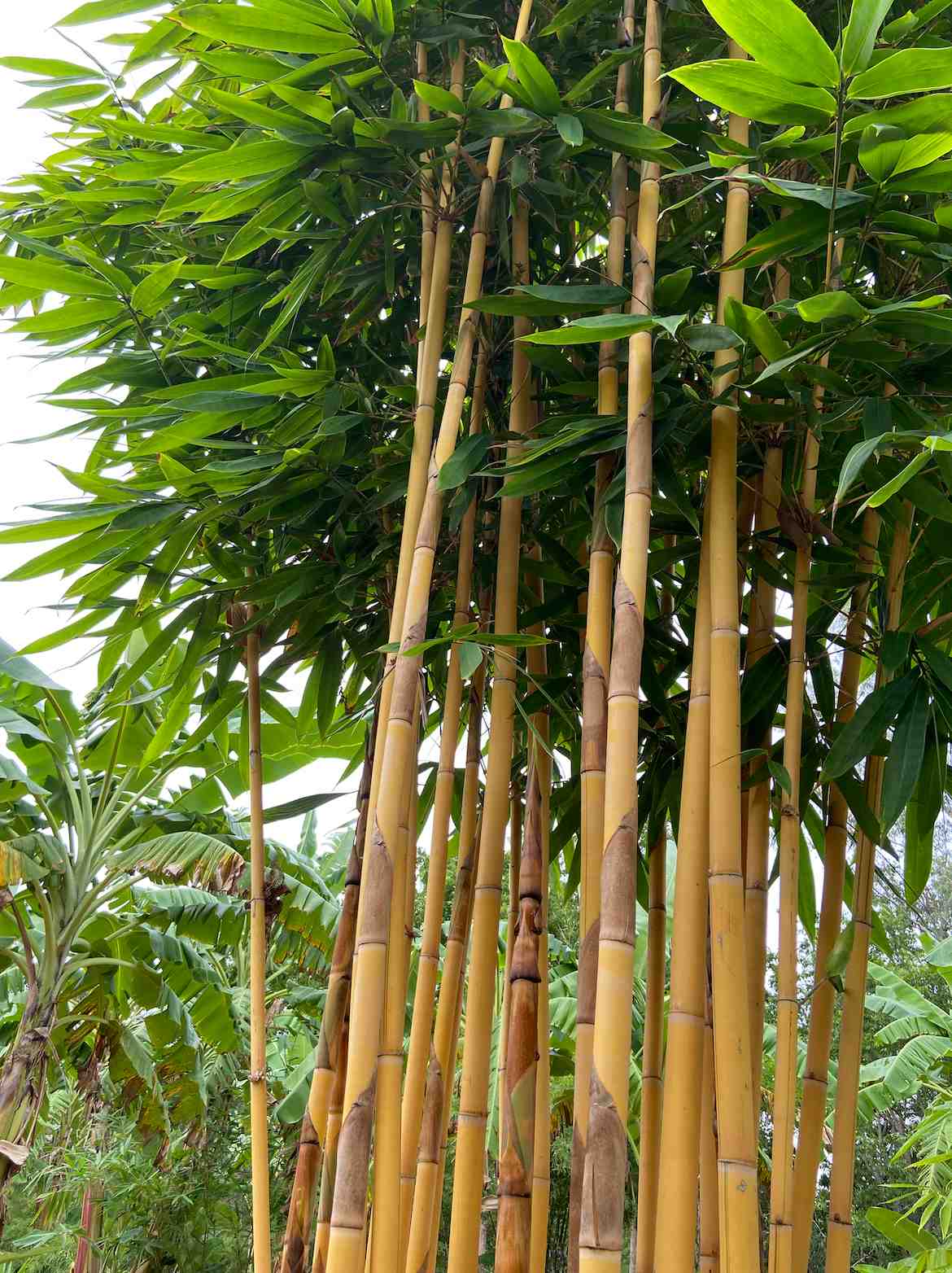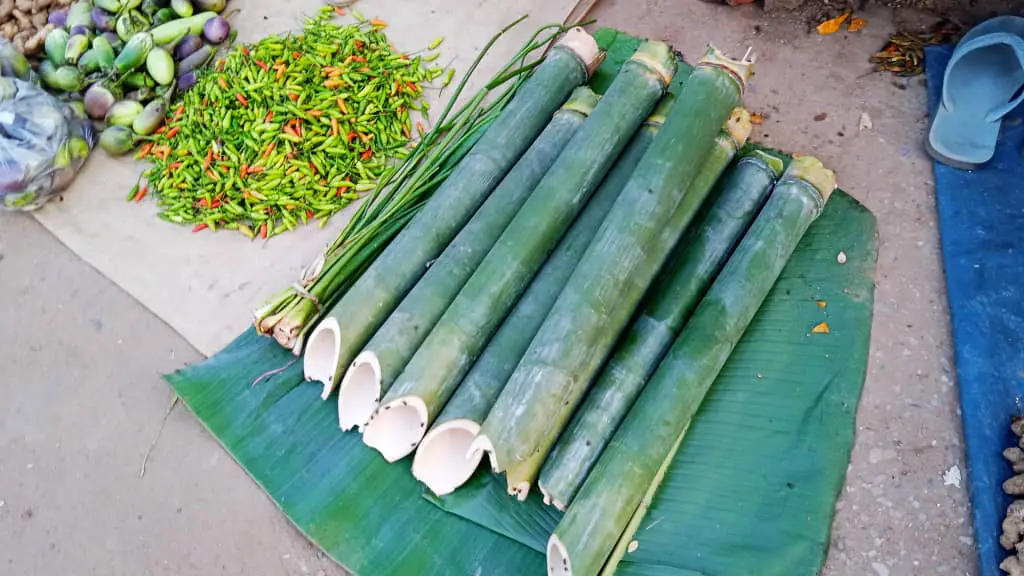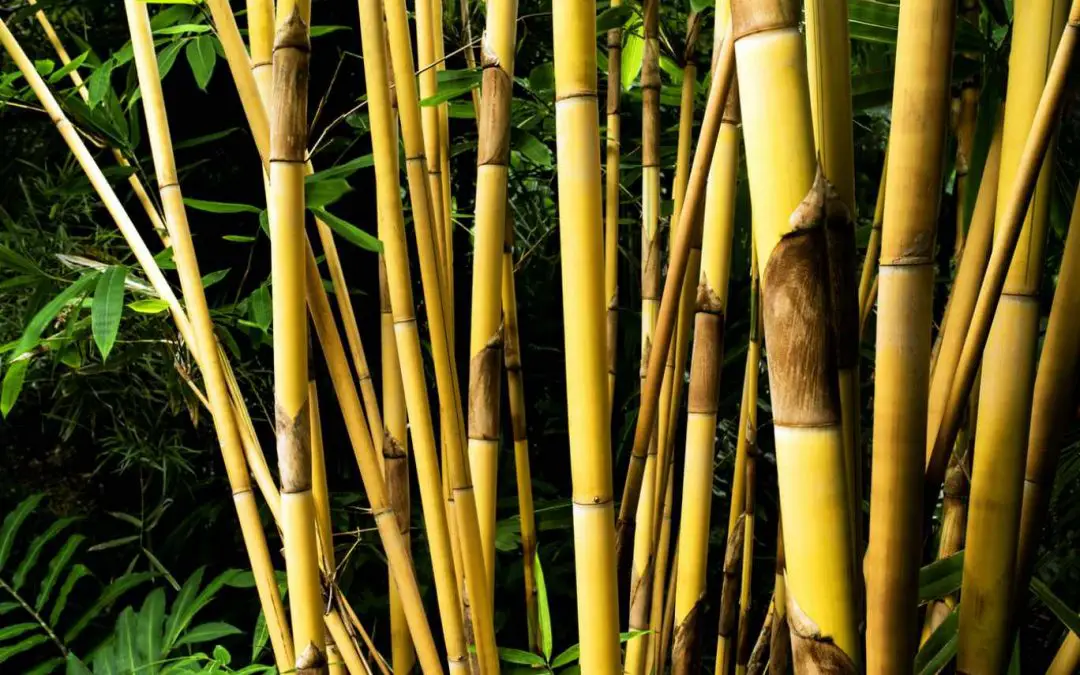It’s more than a mouthful for the average gardener, so you may need a silver tongue as well as a green thumb to pronounce Schizostachyum brachycladum. But don’t let that discourage you. If you enjoy decorative bamboo and live in a warm enough climate, Sacred Bali Bamboo could make a stunning addition to your flourishing garden.
Schizostachyum brachycladum, sometimes known as Sacred Bali Bamboo, is a tropical, clumping species native to Indonesia and Southeast Asia. In warmer climates, free from winter frost, S. brachycladum is a particularly popular ornamental bamboo, admired for its vibrant yellow culms, its dense clumps, and its lush green leaves. In favorable conditions, individual culms can grow 40 or 50 feet tall and 2 to 3 inches thick. This variety of bamboo is neither invasive nor cold-hardy, and its shoots are not considered edible.
NOTE: This article first appeared in February 2022, most recently updated in May 2024.
This article is part of an ongoing series about various bamboo species. Check out some of these other popular links to learn more.
- Introducing Bamboo: Genus by genus
- Bambusa balcooa: Beema Bamboo
- Bambusa oldhamii: Oldham’s Bamboo
- Chimonobambusa quadrangularis: Square Bamboo
- Dendrocalamus asper: Giant bamboo
- Melocanna baccifera: Ideal for erosion
- Phyllostachys nigra: Black Bamboo
- Pseudosasa japonica: Arrow bamboo
- Semiarundinaria fastuosa: Temple bamboo
- Thyrsostachys siamensis: Monastery bamboo
Characteristics of Schizostachyum brachycladum
The most distinguishing features of this bamboo species are the bold colors of its leaves and culms. The upright, stately stalks can grow up to 40 or 50 feet tall in a warm, humid climate. They have a striking yellow hue, in stark contrast to the deep, luscious green of the long, wide leaves.
The lowest several feet of the plant generally have little or no foliage, proudly exposing the smooth culms and their eye-catching color. The culm sheaths can be pretty persistent, as shown in the photo above, providing another interesting contrast between the golds and browns.
The genus Schizostachyum includes around seventy different species, mostly from Southeast Asia, but also occurring as far off as Madagascar and some Pacific Islands. Despite their wide distribution, these are strictly tropical bamboos, and they all need warm weather year-round to really thrive.
This species is most widespread in Indonesia, hence the common nickname, Sacred Bali Bamboo. The botanical name, Schizostachyum, refers to the cleft spikelets on the flowers. This bamboo actually flowers annually, but inconspicuously. And the plant doesn’t die after flowering, the way some bamboos do.
(See our in-depth article The bamboo flowering phenomenon to learn more.)
But don’t confuse Sacred Bali Bamboo with ‘sacred bamboo’ or ‘heavenly bamboo’. These are nicknames for the flowering ornamental plant Nandina domestica, which is neither a bamboo nor even a member of the grass family. Nandina is one of several plants whose name or appearance causes it to get mistaken for bamboo.

Tropical treasure
Like most tropical bamboo varieties, S. brachycladum has a clumping growth habit. So unlike running bamboo, which sends rhizomes out in all directions away from the primary root mass, the clumping rhizomes like to stay more tightly clustered. As a result, you don’t have to worry about this species spreading out and taking over your garden.
(Read about Running bamboo vs. Clumping bamboo to learn more.)
You can place clumps of Sacred Bali Bamboo close together to form a hedge or privacy screen. Their height and density make for an effective windbreak. More often, the beautiful clumps stand alone as specimen plants. They can be the highlight or an attractive addition in any tropical garden. For a more dynamic garden composition, try planting short, flowering shrubs like hibiscus in front of the golden bamboo for a lively splash of color.
As a tropical bamboo, you won’t be able to grow this variety in most US gardens. They can tolerate temperatures down to about 28-30º F, but if that happens regularly, the plant won’t reach its full potential. You might fall in love with this bamboo while traveling in Bali, but don’t try it at home unless you live in South Florida or Hawaii. They also prefer regular irrigation (or rain), and they do grow well in the shade.

Uses for Schizostachyum brachycladum
The primary function of this exquisite bamboo is as a garden ornamental. The smooth golden canes and thick green foliage make a beautiful impression. But like most species of bamboo, you can find many other uses for this glorious grass.
With a diameter of 2 to 3 inches, the poles of S. brachycladum are pretty substantial. But the culm walls are thin. That means they’ll sway nicely in the breeze, but won’t hold up particularly well in a construction project. Instead, traditional crafters and woodworkers usually split this bamboo into strips, and weave it into baskets or floor mats. You wouldn’t build a house with it, but you can make some nice picture frames or other attractive decor for your tiki lounge.
Most Asian bamboo species have edible shoots, popular in stir fry and other dishes. But the young shoots of this bamboo are not considered palatable. They have a strong, bitter taste. If you’re hungry in Southeast Asia, you’re better off looking for some Dendrocalamus asper or some variety of Bambusa.
Genus Schizostachyum
Although it’s not the most well-known group of bamboo, this widespread genus is found across India, Southeast Asia, and the Pacific Islands, and includes nearly 70 distinct species.
Another particularly interesting member of this genus is Schizostachyum dullooa. Common in northeast India, this unusual variety of bamboo is remarkable for its long internodes, often more than one meter (40 inches) in length. The poles grow about ten meters (35-40 feet) tall and 5 to 8 cm (2 to 3 inches) in diameter. Thin walls make this bamboo inferior for building and construction but ideal for crafts and weaving. The culms are also used for carrying water in the field and as containers for storing grains, spices, and other materials.

Follow your bamboo bliss
If you have a passion for ornamental grasses and enjoyed learning about Sacred Bali Bamboo, you can find hours of stimulating reading material throughout the Bambu Batu website. Consider perusing some of these informative articles.




















